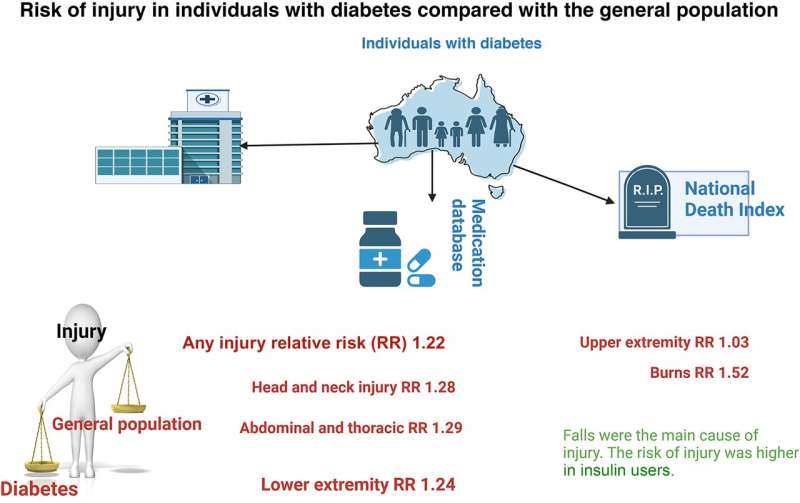This article has been reviewed according to Science X's editorial process and policies. Editors have highlighted the following attributes while ensuring the content's credibility:
fact-checked
peer-reviewed publication
proofread
People with diabetes who are treated with insulin have a 60% increased risk of serious injury, finds study

People with diabetes who are treated with insulin have more than a 60% increased risk of being hospitalized for injuries which include head and neck trauma, and burns, compared to the general population, according to a concerning new study by Australian researchers.
The Baker Heart and Diabetes Institute says the high risk of injury in people with type 1 diabetes and those with insulin-treated type 2 diabetes could be attributed to their likelihood of hypoglycemic falls, when blood sugar levels dip dangerously low; and poorer eyesight and neuropathy, where decreased protective sensation makes individuals unaware that they are being burned.
Frailty and loss of muscle strength in people with diabetes are also concerning issues that warrant consideration when it comes to injury, Baker Institute experts say.
The findings, outlined in Diabetes Care and presented at the American Diabetes Association Scientific Sessions in Florida this week by Berhanu Feleke, provide critical information for people with diabetes, health professionals and policymakers.
The study's authors, led by Professors Jonathan Shaw and Dianna Magliano, call for intervention programs to consider falls prevention strategies and development of muscle strength in people with diabetes associated with insulin-use.
The study also serves as a powerful reminder of the new and emerging complications of diabetes. While many people are aware of the traditional complications of diabetes such as eye, heart and kidney disease, this study reinforces the need to broaden that focus to include emerging issues such as disability and frailty.
Based on data obtained from the diabetes schemes and datasets from 2011–2017, the study looked at more than 117,000 people with diabetes and more than 3.4 million people in the general population who were hospitalized due to an injury.
Among the findings, the study found:
- Falls made up 69% of injuries in people with diabetes, and 80% of head and neck injuries were attributed to falls.
- Among those with diabetes who suffered burns, 23% were associated with neuropathy (a nerve condition that can lead to loss of sensation, pain, weakness or tingling in one or more parts of the body).
- Compared to the general population, people with type 1 diabetes experienced a 60% increased risk of hospital admission for an injury.
- Compared to the general population, the risk of admission for any injury was 65% higher risk for those with type 2 diabetes using insulin but was only a 7% higher risk than the general population among people with type 2 diabetes not using insulin.
- Excess hospitalization was higher among men with diabetes, reflecting a higher risk for injury among men.
Study author and diabetes clinician, Professor Jonathan Shaw says hypoglycemia is believed to contribute to the high rate of falls, with peripheral neuropathy and poorer eyesight from diabetic retinopathy also believed to play a part.
Professor Shaw says while many people may know that 'hypos' can lead to falls, it is not adequately appreciated that this is leading to an increased risk of serious trauma. Similarly, it may not be widely known that almost one in four burns admissions were associated with neuropathy.
He says people with type 1 diabetes, for example, are also at greater risk of injury as they exhibit a lower bone mineral density compared to those without diabetes, with other studies showing they were more than six times more likely to experience a hip fracture than the general population.
Also of concern is that individuals with diabetes face a 2–3 times higher risk of sarcopenia, a condition characterized by decreased muscle mass and strength.
"We need people with diabetes, health professionals and policymakers to be aware that muscle strength, frailty and neuropathy should be firmly on their radar alongside blood glucose management and poor eyesight," Professor Shaw says.
"People with diabetes on insulin are at significantly higher risk of injury and this information should be used to create awareness, plan prevention strategies and provide appropriate support and resources."
More information: Berhanu Elfu Feleke et al, Excess Risk of Injury in Individuals With Type 1 or Type 2 Diabetes Compared With the General Population, Diabetes Care (2024). DOI: 10.2337/dc24-0469


















